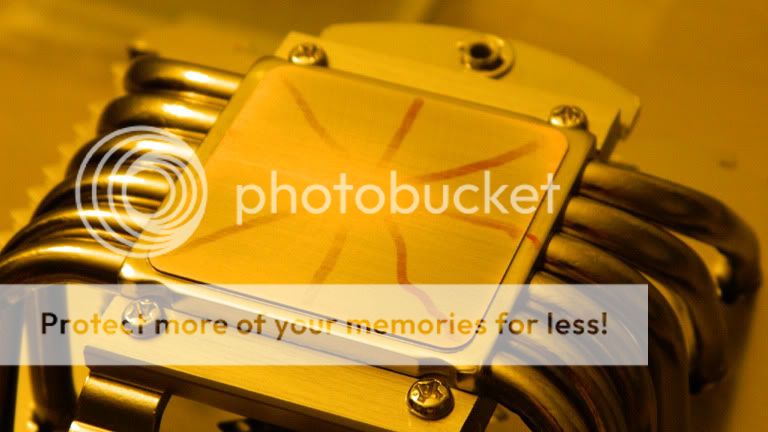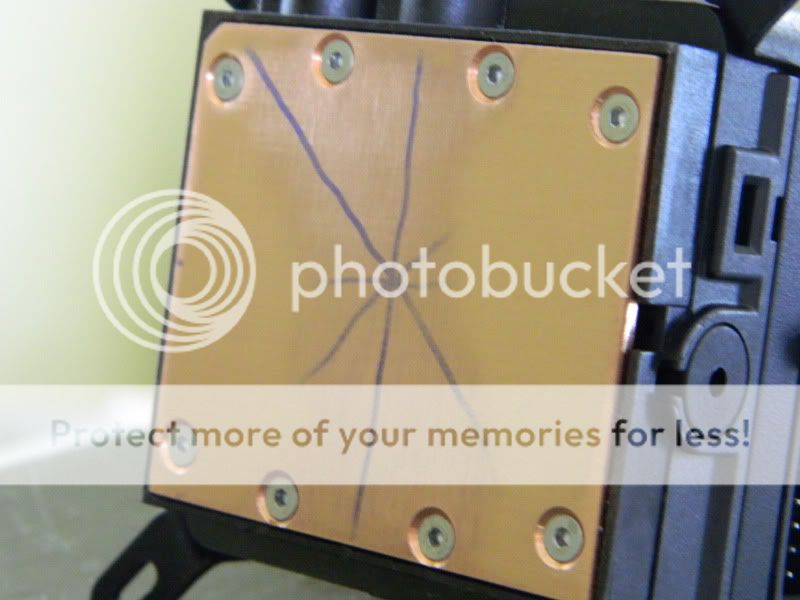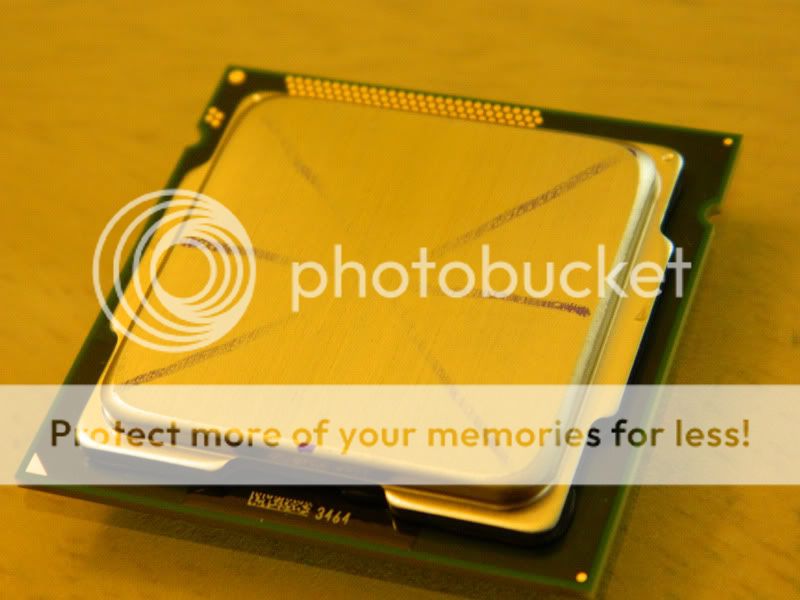Does lapping work?
Page 2 - Seeking answers? Join the AnandTech community: where nearly half-a-million members share solutions and discuss the latest tech.
You are using an out of date browser. It may not display this or other websites correctly.
You should upgrade or use an alternative browser.
You should upgrade or use an alternative browser.
tigersty1e
Golden Member
- Dec 13, 2004
- 1,963
- 0
- 76
lapping worked well back in the days when dies were huge and more squarish.
the best benefit for lapping is you need less pressure to achieve good cooling. now, we have up to 70 pounds of pressure on sockets, so lapping is not as needed.
but if you're using one of those all in 1 coolers that has very little mounting pressure, then you'll see the best benefit there.
the best benefit for lapping is you need less pressure to achieve good cooling. now, we have up to 70 pounds of pressure on sockets, so lapping is not as needed.
but if you're using one of those all in 1 coolers that has very little mounting pressure, then you'll see the best benefit there.
BonzaiDuck
Lifer
- Jun 30, 2004
- 15,730
- 1,457
- 126
I always weigh in when I see this question.
Lapping voids the warranty. If you choose to do it, you have a choice of testing the processor (to make sure it wasn't defective when you received it) before you lap and void the warranty. Often, I don't bother with that step, even so.
Lapping -- if done with reasonable care -- isn't likely to damage the processor.
De-lidding on the other hand -- has a higher risk associated with it.
On a processor with a 95W TDP, lapping only the processor is worth a temperature reduction of about 5C.
All you need to do is to remove the nickel plating and assure the IHS is almost perfectly flat.
If the heatsink has a nickel-plated base, you may capture another 5C by lapping off the nickel (and assuring flatness.)
Of course, the choice of TIM will assist or hinder. I use diamond paste. But there are probably some better solutions that involve use of exotic metals (Germanium?): Coollaboratory and Indigo-Extreme. The diamond paste may buy you another 2C temperature reduction; the latter products may be worth about 4C.
Lapping voids the warranty. If you choose to do it, you have a choice of testing the processor (to make sure it wasn't defective when you received it) before you lap and void the warranty. Often, I don't bother with that step, even so.
Lapping -- if done with reasonable care -- isn't likely to damage the processor.
De-lidding on the other hand -- has a higher risk associated with it.
On a processor with a 95W TDP, lapping only the processor is worth a temperature reduction of about 5C.
All you need to do is to remove the nickel plating and assure the IHS is almost perfectly flat.
If the heatsink has a nickel-plated base, you may capture another 5C by lapping off the nickel (and assuring flatness.)
Of course, the choice of TIM will assist or hinder. I use diamond paste. But there are probably some better solutions that involve use of exotic metals (Germanium?): Coollaboratory and Indigo-Extreme. The diamond paste may buy you another 2C temperature reduction; the latter products may be worth about 4C.
Sometimes it helps alot sometimes not.
My i7 930 had a large depression that im 100% sure would have effected temps(never ran it before i lapped it though) it took me hours and hours to flatten it out and get it to a 6000 grit mirror polish, it was the largest defect in a CPU i have ever lapped. Im sure its contributing to me obtaining the overclock i am running now, it hits 90c under load in the summer.
On my MSI Cyclone 460 the before and after lapping temps were in the 5-8c range of difference.
In the past(ive been lapping since the k6-2 days) the most common difference i noticed was 3-5c, which can very well mean the difference of being able to obtain a stable overclock and not(i tend to push my OC's to the absolute edge). Not to mention a 5c difference in a loaded 24/7 system will extend its lifespan, temp is the biggest killer of electronics.
So in my experiance lapping does indeed help, and i would reccomend it to anyone who is competent enough to build there own PC, its not hard just time consuming.
Edit grammer.
My i7 930 had a large depression that im 100% sure would have effected temps(never ran it before i lapped it though) it took me hours and hours to flatten it out and get it to a 6000 grit mirror polish, it was the largest defect in a CPU i have ever lapped. Im sure its contributing to me obtaining the overclock i am running now, it hits 90c under load in the summer.
On my MSI Cyclone 460 the before and after lapping temps were in the 5-8c range of difference.
In the past(ive been lapping since the k6-2 days) the most common difference i noticed was 3-5c, which can very well mean the difference of being able to obtain a stable overclock and not(i tend to push my OC's to the absolute edge). Not to mention a 5c difference in a loaded 24/7 system will extend its lifespan, temp is the biggest killer of electronics.
So in my experiance lapping does indeed help, and i would reccomend it to anyone who is competent enough to build there own PC, its not hard just time consuming.
Edit grammer.
Last edited:
Just lapped my new Evo due to an extremely rough finish. I did not check it for flatness before hand and was surprised to find that there was a round concave area about the size of a quarter right in the sweet spot of the surface. I lapped it to a flat smooth surface and remounted it. It dropped my 3770k temp about 3 to 4 degrees at idle. I have built dozens of computers over the past 20 years using many brands of aftermarket heat sinks and was really disappointed in the finish of this Cooler Master 212 Evo.
soccerballtux
Lifer
- Dec 30, 2004
- 12,554
- 2
- 76
Does lapping work?
A friend of mine just told me that lapping is the greatest thing.
I'm skeptical. I figure that the thermal paste can do its job.
How many degrees Celsius will my temps drop if I lap my 2500k and my heatsink?
Lapping works if the surfaces are not matched to begin with.
Two flat surfaces are a match, flat on flat is a match.
Likewise one convex surface nested onto a concave surface of equal radius of curvature will be a match. Neither is flat but their surfaces are still geometrically matched.

And yet a third criterion comes into play - flex. Or to be more scientific and specific - strain.
With this you match two intentionally convex surfaces which are designed to "flatten out" (elastic deformation under strain) under the mount pressure (stress, i.e. load) when you tighten the bolts on your block.
Generally lapping only needs to be done when you have mismatched concave surfaces, valleys that end up being filled full of TIM that has less than optimal heat conduction.
My NH-D14 was convex, the center was a high point. This HSF did not need to be lapped as the convex center would just force the IHS to deform and conform to itself as a matching surface under the load provided by the mount.

However, my H100 was extremely concave, the center bowed inwards (away from the IHS) as you can see here when the hash-marks on the surface would only polish away at the edges of the surface:

But remember, this kind of works like addition and trying to get an even number as the result - two even number will always make an even number, and two odds numbers added together always make an even number, but an even number plus and odd number always leaves you with an odd number.
You can have a convex or a concave HSF surface and be fine without lapping so long as the IHS surface is convex enough to fill in the gap of the concave surface when all the bending and flexing is factored in from the mount pressure. What you can't have is two concave surfaces, that is when you really need to lap.
In my case, my specific 2600K had a convex IHS surface, so lapping for flatness sake was unnecessary (but I did it anyway just for that extra degree or two of cooling that comes from minimizing total surface area of the mated surfaces):

Kristijonas
Senior member
- Jun 11, 2011
- 859
- 4
- 76
Probably just for the laughs:
http://hallicino.hubpages.com/hub/How-to-destroy-your-CPU-by-lapping-it
http://hallicino.hubpages.com/hub/How-to-destroy-your-CPU-by-lapping-it
Probably just for the laughs:
http://hallicino.hubpages.com/hub/How-to-destroy-your-CPU-by-lapping-it
I completely agree that that specific guy, and anyone for whom his article resonates with, should absolutely steer clear of all things lapping :thumbsup:
Uh, that doesn't address my question in the slightest. Unless there is a test somewhere where someone mounted and unmounted his HS 10 times to get a sample average, lapped the CPU/HS, and then mounted/unmounted the HS 10 more times and showing the stats of the temps were statistically valid...
I agree with your statement, It very well could have been the factory paste was not applied correctly and he thought the lapping dropped the temps when in reality it could have just been he did a better job of applying the heatsink and compound.
I think to properly lap anything you would need some sort of jig and a surface that is 100 percent flat. Most use a kitchen countertop or piece of wood from home depot. They end up lapping to a un verified surface that is assumed to be flat but might actually be putting a warp in the heatsink they are attempting to flatten.
Can't stop them from doing it, its all part of their OCD, they have to lap.
Last edited:
Saw this thread and thought I would add my experiences.
Lapping works if done correctly and you will normally see a 3-5c drop in temps.
Removing the ihs is not advisable to do with current cpus as you are likely to fracture the silicon in the process. You will also have a problem making contact with the heatsink if the ihs is removed.
When lapping be very gentle when sliding the chip across the sand paper, as you can easily deform the surface yourself. Keep the paper rather damp the entire time with slightly soapy water. Rinse the paper off if too much metal accumulates before moving to a finer grit.
If lapping both the ihs and the heatsink, be aware you can overdo it and lose clamping pressure, which negates the lap and sometimes makes things worse.
As far as I know, and having lapped many processors myself, static is not an issue. I have done it in varied environments, all the way to wearing socks on carpet at my coffee table, and have yet to have a problem.
Finally, lapping is not for everybody, it is for the performance-obsessed. There are easier things you can do to reduce temperatures, such as improving case airflow, buying a better heatsink, and using high-end thermal interface materials.
Lapping works if done correctly and you will normally see a 3-5c drop in temps.
Removing the ihs is not advisable to do with current cpus as you are likely to fracture the silicon in the process. You will also have a problem making contact with the heatsink if the ihs is removed.
When lapping be very gentle when sliding the chip across the sand paper, as you can easily deform the surface yourself. Keep the paper rather damp the entire time with slightly soapy water. Rinse the paper off if too much metal accumulates before moving to a finer grit.
If lapping both the ihs and the heatsink, be aware you can overdo it and lose clamping pressure, which negates the lap and sometimes makes things worse.
As far as I know, and having lapped many processors myself, static is not an issue. I have done it in varied environments, all the way to wearing socks on carpet at my coffee table, and have yet to have a problem.
Finally, lapping is not for everybody, it is for the performance-obsessed. There are easier things you can do to reduce temperatures, such as improving case airflow, buying a better heatsink, and using high-end thermal interface materials.
Pohemi
Diamond Member
- Oct 2, 2004
- 8,938
- 11,563
- 146
How do you (generally) lap a large, unwieldy HSF? Such as an AIO system where the block can't be removed for easier handling?
It's far easier to lap the CPU simply because it's smaller and easier to hold, but I'm more likely to want to do it to my HS first, especially if it's one that's been re-used on multiple CPUs...
Edit: I've got a Zalman CNP9000 HSF, and it's hard to hold/grip it anywhere above the block, much less putting even pressure on the plate while trying to slide it across the paper.
It's far easier to lap the CPU simply because it's smaller and easier to hold, but I'm more likely to want to do it to my HS first, especially if it's one that's been re-used on multiple CPUs...
Edit: I've got a Zalman CNP9000 HSF, and it's hard to hold/grip it anywhere above the block, much less putting even pressure on the plate while trying to slide it across the paper.
Last edited:
How do you (generally) lap a large, unwieldy HSF? Such as an AIO system where the block can't be removed for easier handling?
It's far easier to lap the CPU simply because it's smaller and easier to hold, but I'm more likely to want to do it to my HS first, especially if it's one that's been re-used on multiple CPUs...
Edit: I've got a Zalman CNP9000 HSF, and it's hard to hold/grip it anywhere above the block, much less putting even pressure on the plate while trying to slide it across the paper.
Lapping a HSF is really not so different from lapping a cpu. You go slow, you take your time, and you get the job done.
The only challenge I ever personally had in lapping were with my H100 and VapoLS because they attached hardware (radiator for the H100, compressor for the VapoLS) limits your mobility while lapping the block.
For lapping the H100, I assembled a little "shuttle" out of a shoe-box and washcloth for the radiator to ride on as I slide the waterblock back and forth on the sandpaper.
Here's a video I captured and uploaded a while back showing it in action.
TRENDING THREADS
-
Discussion Intel current and future Lakes & Rapids thread
- Started by TheF34RChannel
- Replies: 23K
-
Discussion Zen 5 Speculation (EPYC Turin and Strix Point/Granite Ridge - Ryzen 9000)
- Started by DisEnchantment
- Replies: 10K
-
Discussion Speculation: Zen 4 (EPYC 4 "Genoa", Ryzen 7000, etc.)
- Started by Vattila
- Replies: 13K
-
Discussion Intel Meteor, Arrow, Lunar & Panther Lakes Discussion Threads
- Started by Tigerick
- Replies: 8K
-

AnandTech is part of Future plc, an international media group and leading digital publisher. Visit our corporate site.
© Future Publishing Limited Quay House, The Ambury, Bath BA1 1UA. All rights reserved. England and Wales company registration number 2008885.

